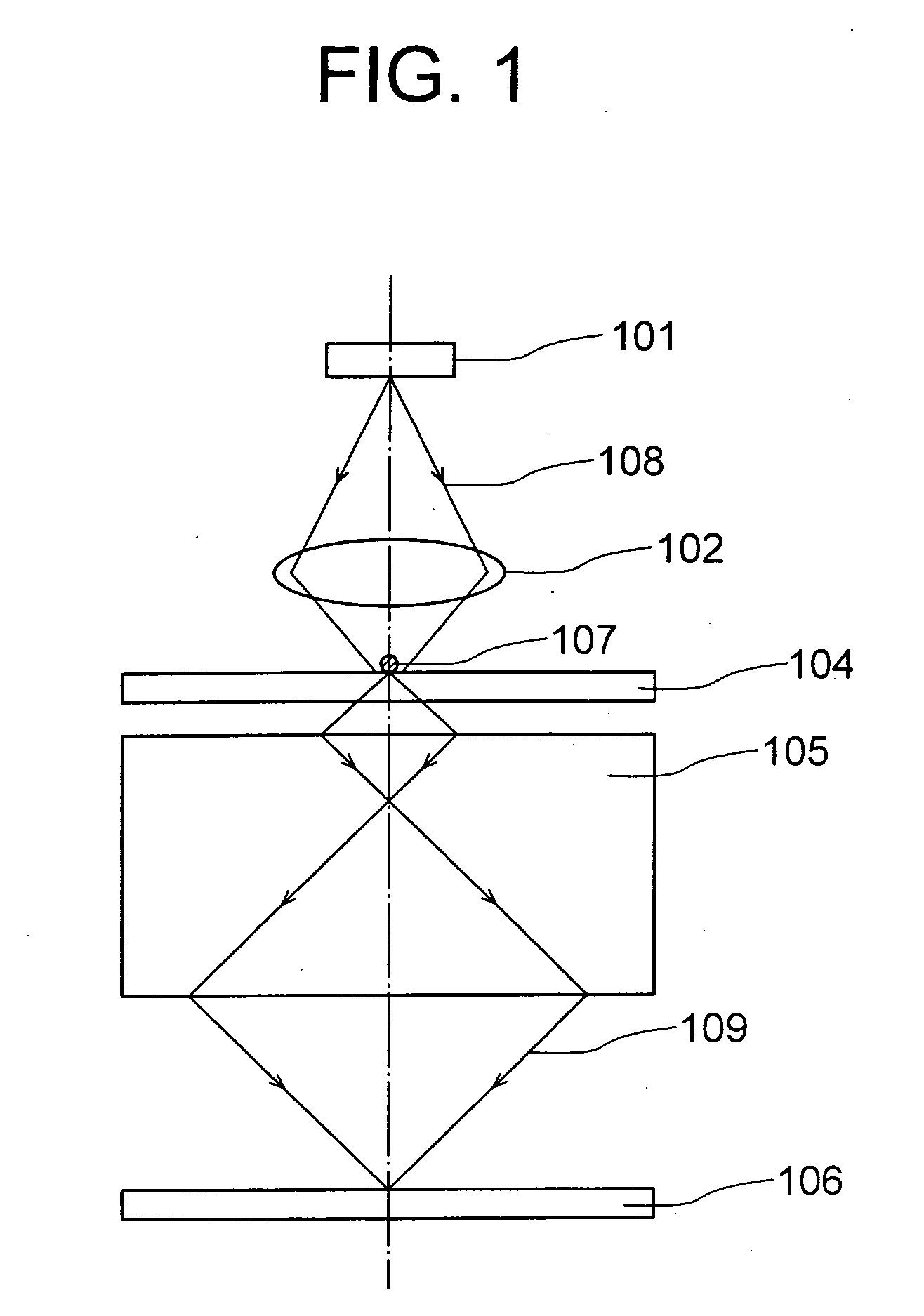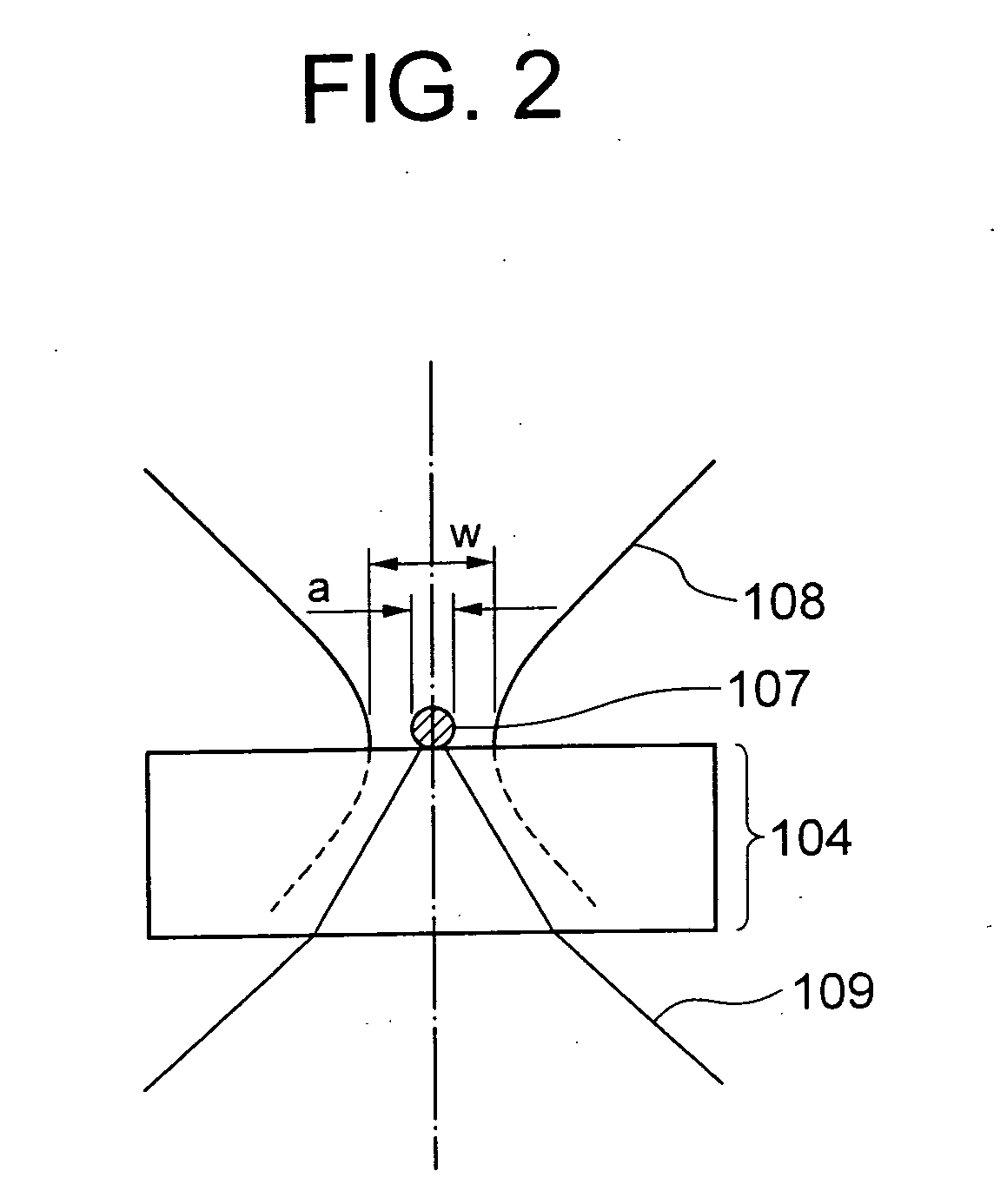Lighting system, method of lighting, and scanning optical microscope
a scanning optical microscope and light source technology, applied in the field of scanning optical microscopes, lighting systems, lighting and heating apparatuses, instruments, etc., can solve the problems of inability to carry out image dissection of structures smaller than the diffraction limit, limited resolution capacity of image pickup optical systems,
- Summary
- Abstract
- Description
- Claims
- Application Information
AI Technical Summary
Benefits of technology
Problems solved by technology
Method used
Image
Examples
first embodiment
[0074]FIG. 1 shows a structure of a lighting system according to a first embodiment. A light source 101 is an illuminating light source such as a halogen lamp, a light emitting diode (LED), a super luminescent diode (SLD), and a laser oscillator, and since the laser light has a superior spatial coherence, it is preferable from a point of forming a beam spot having a higher energy density. A light emitter excitation light 108 of a wavelength λ1 which the light source 101 has emitted, is focused on a light emitter 107 by a collective lens 102. The light emitter 107 is a fine particle made of a florescent substance or a phosphorescence substance which emits light of a wavelength longer than excitation light by irradiating the excitation light, and a size of the light emitter 107 is smaller than a wavelength of the fluorescent light or the phosphorescent light emitted by the light emitter 107.
[0075]As the light emitter 107, it is possible to use a so-called fluorescent bead in which, pl...
second embodiment
[0080]Next, a second embodiment of the present invention will be described below. Same reference numerals are assigned to components which are same as in the first embodiment, and repeated description is omitted. FIG. 3 shows a structure of a lighting unit according to the second embodiment. A structure of the second embodiment is basically same as the structure of the first embodiment, and differs at a point of having a light emitting layer 201. The light emitting layer 201 is a film formed on the substrate 104, in which, a plurality of light emitters 107 is disposed by being dispersed spatially in a transparent substance.
[0081]FIG. 4 is a diagram in which, the light emitting layer 201 and the substrate 104 in FIG. 3 are enlarged. The light emitting layer 201 is formed by making the plurality of light emitters 107 to be dispersed in a film made of a transparent material.
[0082]The light emitter 107 being extremely small, when there is only one light emitter held on the substrate 104...
third embodiment
[0085]Next, a third embodiment of the present invention will be described below. Same reference numerals are assigned to components which are same as in the embodiments described above, and the repeated description is omitted. In the first embodiment (FIG. 1) and the second embodiment (FIG. 3), since the fluorescent light emitted by the light emitter 107 passes through the substrate 104, there is a possibility that the beam spot formed on the object 106 is blurred due to scattering and absorption of the fluorescent light inside the substrate, or due to the scattering and reflection at a surface of the substrate. Therefore, as shown in FIG. 6, when the light emitter 107 is held at a rear side of the substrate 104 (as seen from a light source side), it is possible to avoid an occurrence of the blurring. Moreover, for achieving the same effect, as shown in FIG. 7, a structure in which, the negative refraction lens 105 holds the light emitter 107, without using the substrate 104 is also...
PUM
 Login to View More
Login to View More Abstract
Description
Claims
Application Information
 Login to View More
Login to View More - R&D
- Intellectual Property
- Life Sciences
- Materials
- Tech Scout
- Unparalleled Data Quality
- Higher Quality Content
- 60% Fewer Hallucinations
Browse by: Latest US Patents, China's latest patents, Technical Efficacy Thesaurus, Application Domain, Technology Topic, Popular Technical Reports.
© 2025 PatSnap. All rights reserved.Legal|Privacy policy|Modern Slavery Act Transparency Statement|Sitemap|About US| Contact US: help@patsnap.com



